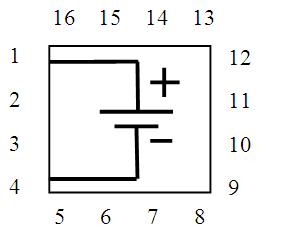Rechargeable Thin Film Battery 50µAh, 3.8V

Features
• All Solid State
• SMT Package and Process
• Lead-Free Reflow Tolerant
• Thousands of Recharge Cycles
• Low Self-Discharge
• Eco-Friendly, RoHS Compliant
Electrical Properties
Output voltage: 3.8V
Capacity (typical): 50µAh
Charging source: 4.00V to 4.15V
Recharge time to 80% 50 minutes
Charge/Discharge cycles: >5000 to 10% Discharge
Physical Properties
Package size: 8 mm x 8 mm
Operating temperature: -20¡ÆC to 70¡ÆC
Storage temperature: -40¡ÆC to 125¡ÆC
Applications
• Standby supply for non-volatile SRAM, real-time clocks, controllers, supply supervisors, and other system-critical components.
• Wireless sensors and RFID tags and other powered, low duty cycle applications.
• Localized power source to keep microcontrollers and other devices alert in standby mode.
• Power bridging to provide backup power to system during exchange of main batteries.
• Energy Harvesting by coupling the EnerChip with energy transducers such as solar panels.
|
Pin Number(s) |
Descript-xion |
|
1 |
V+ |
|
4 |
V- |
|
2,3 |
NIC |
|
5-16 |
NIC |
|
Note: NIC = No Internal Connection |
The EnerChip¢â CBC050 is a surface-mount, solid state, rechargeable battery rated for 50¥ìAh at 3.8V. It is ideal as a localized, on-board power source for SRAMs, real-time clocks and microcontrollers which require standby power to retain time or data. It is also suitable for RFID tags, smart sensors, and remote applications which require a miniature, low-cost, and rugged power source. For many applications, the CBC050 is a superior alternative to coin cell batteries and supercapacitors.
Because of their solid state design, EnerChip¢â batteries are able to withstand solder reflow temperatures and can be processed in high-volume manufacturing lines similar to conventional semiconductor devices. There are no harmful gases, liquids or special handling procedures, in contrast to traditional rechargeable batteries.
The EnerChip recharge is fast and simple, with a direct connection to a 4.1V voltage source and no current limiting components. Recharge time is 50 minutes to 80% capacity. Robust design offers thousands of charge/discharge cycles. The CBC050 is packaged in an 8 mm x 8 mm quad flat package. It is available in reels for use with automatic insertion equipment.

Top View - CBC050 Schematic
Operating Characteristics
|
Parameter |
Condition |
Min |
Typical |
Max |
Units |
|
Discharge Cutoff Voltage |
25¡ÆC |
3.0(1) |
- |
- |
V |
|
Charge Voltage |
25¡ÆC |
4.0(2) |
4.1 |
4.3 |
V |
|
Pulse Discharge Current |
25¡ÆC |
300(3) |
- |
- |
¥ìA |
|
Cell Resistance |
25¡ÆC |
- |
1500 |
3000 |
¥Ø |
|
Self-Discharge (average) |
non-recoverable |
- |
2.5 |
- |
% per year |
|
recoverable |
|
8(4) |
|
% per year |
|
Operating Temperature |
- |
-20 |
25 |
70 |
¡ÆC |
|
Recharge Cycles
(to 80% of rated capacity; 4.1V charge voltage) |
25¡ÆC |
10% depth-of-discharge |
5000 |
- |
- |
cycles |
|
50% depth-of discharge |
1000 |
- |
- |
cycles |
|
40¡ÆC |
10% depth-of-discharge |
2500 |
- |
- |
cycles |
|
50% depth-of-discharge |
500 |
- |
- |
cycles |
|
Recharge Time (to 80% of rated capacity) |
4.1V constant voltage |
- |
50 |
- |
minutes |
|
Capacity |
8 ¥ìA discharge; 25¡ÆC |
- |
50 |
- |
¥ìAh |
(1) Failure to cutoff the discharge voltage at 3.0V will result in battery performance degradation.
(2) Charging at 4.0V will charge the cell to approximately 70% of its rated capacity.
(3) Typical pulse duration = 20 milliseconds.
(4) First month recoverable discharge is 5% average.
Note: All specifications contained within this document are subject to change without notice
